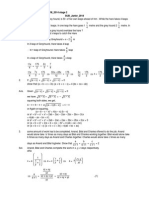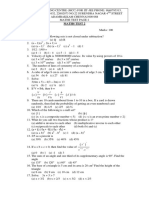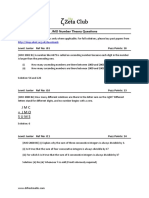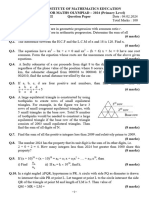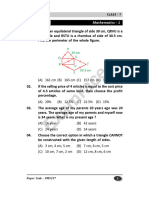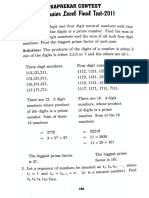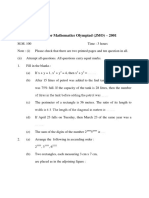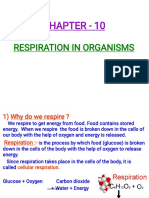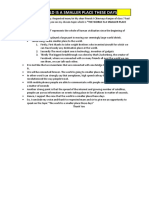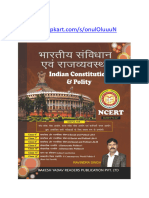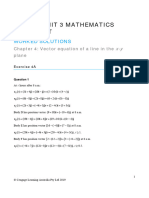THE ASSOCIATION OF MATHEMATICS TEACHERS OF INDIA
KAPREKAR CONTEST - FINAL - SUB JUNIOR
Classes VII & VIII
Saturday, 28th October_2017.
Instructions:
1. Answer as many questions as possible.
2. Elegant and novel solutions will get extra credits.
3. Diagrams and explanations should be given wherever necessary.
4. Fill in FACE SLIP and your rough working should be in the answer book.
5. Maximum time allowed is THREE hours.
6. All questions carry equal marks.
1. (a) Find all three digit numbers in which any two adjacent digits differ by 3.
(b) There are 5 cards. Five positive integers (may be different or equal) are written on these cards,
one on each card. Abhiram finds the sum of the numbers on every pair of cards. He obtains
only three different totals 57, 70, 83. Find the largest integer written on a card.
Sol. (a) Let the no. be xyz
x 1 to 9
y 0 to 9
z = 0 to 9
x & y are
x = (1 to 2) or (7 to 9) y = (0 to 2) or (7 to 9) (0 cases)
x = (3 to 6) , y = (0 to 2) or (7 to 9) (6 cases)
(30, 41, 47, 52, 58, 69)
x = (1 to 2) or (7 to 9) y = (3 to 6) (5 cases)
(14,25,74,85,96)
x = (3 to 6) y = (3 to 6) (2 cases)
(36, 63)
No. are
141,147,252,258,303,363,369,414,474,525,585,630,636,696,741,747,852,
858, 963,969 20 Number of there
(b) As the three sum are obtained 57,70,83
We have combination of three numbers same and two numbers different
a, a, a, b, c
a + b = 57
b + c = 70
c + a = 83
2a = 70
a = 35
b = 22
c = 48
Largest integer is 48
NMTC_STAGE-II_PAPER-2017_SUB JUNIOR_PAGE # 1
�2. (a) ABC is a triangle in which AB = 24, BC = 10 and CA = 26 . P is a point inside the triangle.
Perpendiculars are drawn to BC, AB and AC. Length of these perpendiculars respectively
are x, y and z. Find the numerical value of 5x + 12y + 13z.
2 2 2 2 2 2 2 2 2
(b) If x (y + z) = a , y (z + x) = b , z (x + y) = c , xyz = a b c prove that a + b + c + 2abc = 1
1
Sol. (a) 24 × 10 = 20
2
= ar PAB + PBC + or PAC
1 1 1
120 = x × 10 + z × 26 + y + 24
2 2 2
120 = 5x + 13z + 12 y
26
y P
24
B 10 C
2 2 2 2 2 2
(b) If x (y + z) = a , y (z + x) = b , z (x + y) = c , xyz = a b c
2 2 2 2 2 2
x (y + z) y (z + x) z (x + y) = a b c
2 2 2 2 2 2
x y z (x + y) (y + z) (z + x) = a b c
xyz = abc
(x + y) (y + z) (z + x) = 1
2 2 2
a + b + c + 2abc
2 2 2
x (y + z) + y (z + x) + z (x + y) + 2xyz
Put y = – z
2 2
0 + z (z + x) + z (x – z) + 2x (–z)z
3 2 2 3 2
z + z x + z x – z – 2z x = 0
(y + z) is factors
Similarly (x + y) & (x + z) are factors
2 2 2
x (y + z) + y (z + x) + z (x + y) + 2xyz
= k (x + y) (y + z) (x + z)
For k put x = 0 y = 1 z = 1
0 + 1 + 1 + 0 = k (1) (2) (1)
2=2k
k=1
2 2 2
x (y + z) + y (z + x) + z (x + y) + 2xyz
= (x + y) (y + z) (z + x)
and (x + y) (y + z) (z + x) = 1
2 2 2
x (y + z) + y (z + x) + z (x + y) + 2xyz = 1
2 2 2
a 2 2b 3c 4b 2 3c a 9c 2 a 2b
3. If X
3c a 2 4b 2 a 2b 2 9c 2 2b 3c 2 a 2
2 2 2
9 y 2 4z 2x 16 z 2 2x 3 y 4 x 2 3 y 4z
Y
2x 3y 2 16z 2 3y 4z 2 4x 2 4z 2x 2 9 y 2
Find 2017 (X + Y)
2 2 2
a 2 2b 3c 4b 2 3c a 9c 2 a 2b
Sol. x
3c a2 4b 2 a 2b 2 9c 2 2b 3c 2 a 2
x
a 2b 3c a 2b 3c 2b 3c a 2b 3c a 3c a 2b 3c a 2b
3c a 2b3c a 2b a 2b 3c a 2b 3c 2b 3c a2b 3c a
a 2b – 3c 2b 3c – a 3c a 2b
x
a 2b 3c a 2b 3c a 2b 3c
NMTC_STAGE-II_PAPER-2017_SUB JUNIOR_PAGE # 2
� a 2b 3c 2b 3c a 3c a 2b
x
a 2b 3c
a 2b 3c
x 1
a 2b 3c
2 2 2
9 y 2 4z 2x 16 z 2 2x 3 y 4 x 2 3 y 4z
Y
2x 3y 2 16z 2 3y 4z 2 4x 2 4z 2x 2 9 y 2
Y
3y 4z 2x 3 y 4z 2x 4z 2x 3 y 4z 2x 3 y 2x 3 y 4z 2x 3 y 4z
2x 3y 4z 2x 3 y 4z 3 y 4z 2x 3y 4z 2x 4z 2x 3 y 4z 2x 3 y
3 y 4z 2x 4z 2x 3 y 2x 3 y 4z
Y
2x 3 y 4z 2x 3 y 4z 2x 3 y 4z
3 y 4z 2x 4z 2 x 3 y 2 x 3 y 4z
Y
2x 3 y 4z
2x 3 y 4z
Y 1
2x 3 y 4z
So, 2017 (x + y)
2017 (1 + 1)
2017 × 2 = 4034 Ans.
4. The sum of the ages of a man and his wife is six times the sum of the ages of their children. Two years
ago the sum of their ages was ten times the sum of the ages of their children. Six years hence the sum
of their ages will be three times the sum of the ages of their children. How many children do they have?
Sol. Let present age of man = M
Let present age of wife = W
Let the no. of children = x
Let the sum of the ages of children = C
ATQ
M+W=6C … (1)
M– 2 + W – 2 = 10 (C – 2x ) … (2)
M + 6 + W + 6 = 3 (C + 6x) … (3)
From (2) M + W – 4 = 10 C – 20 x
By using (1) 6 C – 4 = 10 C – 20 x
– 4C + 20x = 4
–C + 5x = 1 … (5)
From (3) M + W + 12 = 3C + 18x
By using (1) 6C + 12 = 3C + 18x
3C – 18x = – 12
C – 6x = – 4 … (6)
From (5) & (6)
–C + 5x = 1
C – 6x = – 4
–x=–3
x=3 Ans.
a
5. (a) a, b, c are three natural numbers such that a x b x c = 27846. If = b + 4 = c - 4,
6
find a + b + c.
(b) ABCDEFGH is a regular octagon with side length equal to a. Find the area of the
trapezium ABDG.
Sol. (a) a ×b × c = 27846 … (1)
a
b4c4
b
a = 6b + 24
b=b
c=b+8
NMTC_STAGE-II_PAPER-2017_SUB JUNIOR_PAGE # 3
� Put value of a, b, c in (1)
(6b + 24) (b) (b + 8) = 27846
6(b + 4) (b) (b + 8) = 27846
(b + 4) (b) (b + 8) = 4641 = 13 × 17 × 3 × 7 = 13 × 17 × 21
b = 13
a = 6 × 13 + 24
= 78 + 24
= 102
c = b + 8 = 13 + 8 = 21
a + b + c = 102 + 13 + 21 = 136
1
(b) Area of trapezium =
(AB + GD) AK
2
1 a a2
a a 1 2 a
2
2 2 2
43 2
A a B
a
2
45° C
H
G D
a K a a
2 2
F E
6. (a) If a, b, c are positive real number such that no two of them are equal, show that
a(a – b) (a – c) + b(b – c) (b – a) + c(c– a) (c – b) is always positive
(b) In the figure below, P, Q, R, S are point on the sides of the triangle ABC such that
CP = PQ = QB = BA = AR = RS = SC
Sol. (a) Let a>b>c
a (a – b) (a – c) – b (b – c) (a – b) + c(c – a) (c – b)
(a – b) [a (a – c) – b (b – c)] + c(c – a) (c – b)
2 2
(a – b) [a – ac – b + bc] + c(c – a) (c – b)
2 2
(a – b) [a – b – (ac – bc)] + c(c – a) (c – b)
(a – b) [(a + b) (a – b) – c(a – b)] + c(c – a) (c – b)
(a – b)2 [a b – c] + c(c – a) (c b)
T1 T2
T1 > 0, T2 > 0
T1 + T2 > 0.
NMTC_STAGE-II_PAPER-2017_SUB JUNIOR_PAGE # 4
� A
x
Q
3x
(b)
x S
2x
x 2x x
2x C
B R P
PCS = x
PC = PQ
PQC = x
QPR= 2x (Exterior angle)
QPR = QBP = 2x
In SRC
SC = SR
SRC = SCR = x
In SRC
At QSR = 2x
In BQP
BQP = 180 – 4x
AQS is a straight line
So, AQB = 3x
QB = AB
BAQ = 3x
AR = RS
RAS = 2x
BAR = x
In ARS
ARS = 180 – 4x
ARB = 3x
AR = AB
ABQ = x
BAC = 3x
ABC = 3x
ACB = x
In ABC
3x + 3x + x = 180
7x = 180
180
x .
7
NMTC_STAGE-II_PAPER-2017_SUB JUNIOR_PAGE # 5


